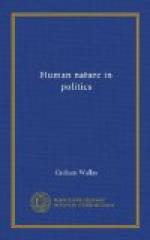‘Thine and thee’ at the end seem to me to express precisely the change from the automatic images of ‘voice’ and ‘face’ to the reflective mood in which the full meaning of that for which he fights is realised.
But it is the ‘face’ that ‘gives the battle to his hands.’ Here again, as we saw when comparing impulses themselves, it is the evolutionarily earlier more automatic, fact that has the greater, and the later intellectual fact which has the less impulsive power. Even as one sits in one’s chair one can feel that that is so.
Still more clearly can one feel it if one thinks of the phenomena of religion. The only religion of any importance which has ever been consciously constructed by a psychologist is the Positivism of Auguste Comte. In order to produce a sufficiently powerful stimulus to ensure moral action among the distractions and temptations of daily life, he required each of his disciples to make for himself a visual image of Humanity. The disciple was to practice mental contemplation for a definite period each morning of the remembered figure of some known and loved woman—his mother, or wife, or sister. He was to keep the figure always in the same attitude and dress, so that it should always present itself automatically as a definite mental image in immediate association with the word Humanite.[12] With that would be automatically associated the original impulse of affection for the person imaged. As soon as possible after that would come the meaning of the word, and the fuller but less cogent emotional associations connected with that meaning. This invention was partly borrowed from certain forms of mental discipline in the Roman Catholic Church and partly suggested by Comte’s own experiences of the effect on him of the image of Madame de Vaux. One of the reasons that it has not come into greater use may have been that men in general are not quite such good ‘visualisers’ as Comte found himself to be.
[12] The Catechism of Positive Religion (Tr. by Congreve), First Part, ‘Explanation of the Worship,’ e.g. p. 65: ’The Positivist shuts his eyes during his private prayers, the better to see the internal image.’
Cardinal Newman, in an illuminating passage of his Apologia, explains how he made for himself images of personified nations, and hints that behind his belief in the real existence of such images was his sense of the convenience of creating them. He says that he identified the ‘character and instinct’ of ‘states’ and of those ’governments of religious communities,’ from which he suffered so much, with spirits ’partially fallen, capricious, wayward; noble or crafty, benevolent or malicious, as the case might he.... My preference of the Personal to the Abstract would naturally lead me to this view. I thought it countenanced by the mention of the “Prince of Persia” in the prophet Daniel: and I think I considered that it was of such intermediate beings that the Apocalypse spoke, when it introduced “the angels of the seven churches."’[13] In 1837 ... I said ... ’Take England with many high virtues and yet a low Catholicism. It seems to me that John Bull is a spirit neither of Heaven nor Hell.’




